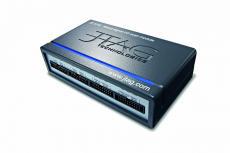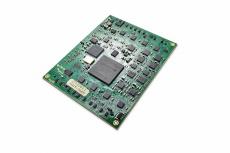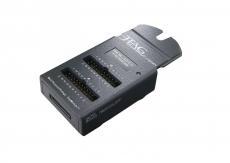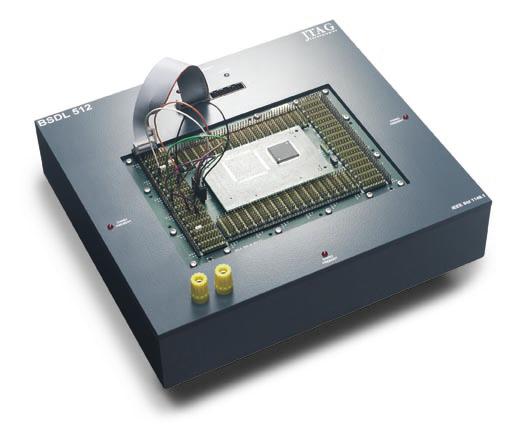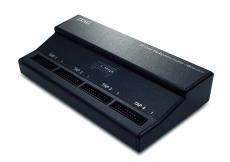JT 5112 MIOS (Mixed-signal IO Scan) extends the capability of JTAG test system with digital analog and frequency measurement options. Allows to measure and source analog values up to 30V on up to eight channels, digital I/O on up to 64 channels. Also feature frequency measurement capability and user programmable functions. Features reconfigurable (via CoreCommander) FPGA kernel to allow custom functions such as high-speed memory access, flash programming, I2C control, CAN bus etc.
JT 5112 is available in an impact-resistant enclosure or as a fixture-embedded version (/FXT). JT 5112 works with all JT 37xx series of controllers. Connections are via standard 0.1" IDC plugs on the front of the unit. JTAG TAP and power connections at the rear.
JT 5112 Specification:
- Compact 64 channel digital/analog I/O system
- 64 I/O channels (56 - always digital, 8 analog or digital)
- Digital output range 1.05V - 3.6V
- Analog range 0.00V-30.00V or -15.00V-15.00V accuracy ± (0.7% + 24mV)
- 16 frequency measurement channels - range 0- 200 MHz
- One channel pulse width counter - range 4 - 8192 ns
- Frequency generator - range 0 - 62.5 MHz
- Supports high TCK frequencies
- Reconfigurable FPGA for custom bus functions
- Software set (SCIL) functions
- Standard IEEE 1149.1 control interface
- Two versions:
- JT 5112 - standard benchtop model. Connectivity through 4 x 20-way IDC format 0.1" connectors (MIOS channels) and 2 x 10-way IDC format 0.1" connectors (TAPs). Supplied with wall PSU
- JT 5112/FXT - fixture-embedded board 74mm x 59mm Connectivity through 2 x 68 pins ERNI SMCQ 68 M 244839 connectors (MIOS and TAPs)
SCIL Modules are a range of pre-programmed, serially controlled pods that usually take the place of a regular TAP pod within the DataBlaster's QuadPod system. They can be used wherever customised testing or programming equipment is needed. Currently available SCIL modules for enhancing test coverage are counter/timer and pattern generator/comparator units. Specific SCIL modules for in-system device programming are also available. They are used in tandem with a SCIP (Serially Controlled IC Programming) software modules. Further SCIL module functions can be developed upon request.
SCIL Modules, based on the JT 2149/MPV 32 channel DIOS module, are available for several logic functions. Alternative 'hosts' for SCIL functions can also be the JT 2111/MPV (desktop DIOS) or the JT 2122/MPV (DIMM DIOS).
JT 2149/MPV-0xx SCIL modules references are as follows:
- 001 - 32 channels DIOS
- 006 - low voltage TAP interface for Intel (Atom etc..)
- 011 - programming adapter Renesas micros
- 015 - programming adapter HC08
- 016 - programming adapter HCS08/HCS12
- 017 - programming adapter HC08/HCS08/HCS12
- 018 - programming adapter (BDM) MPC500 series
- 019 - programming adapter ARM SWD
- 067 - instrument pattern generator
- 071 - instrument pattern generator/comparator
- 037 - protocol engine - Dallas 1 wire
- 034 - protocol engine - Microchip
- 035 - protocol engine - SPI
BSDL Verifier is a generation/verification system which, using a sample boundary-scan IC, automatically verifies the existing BSDL (Boundary-Scan Description Language) file or creates a BSDL file for the device if none exists. All this is done in accordance with the IEEE 1149.1b Boundary-scan Standard. A BSDL file describes the boundary-scan characteristics of a specific device in terms of scan register lengths, ID codes, instruction codes, etc.
BSDL Verifier is for use by device manufacturers to confirm and test the capability of their device's boundary-scan architecture. Reverse engineer BSDL models for legacy devices without accurate data. It can be also used as a simple low-cost tester against counterfeit devices.
BSDL Verifier:
- Offers easy-to-use software and hardware
- Creates and verifies a BSDL model using the actual integrated circuit
- Supports up to 512 signal pins with independent sense, drive, bi-directional, and tri-state capabilities
- Supports a wide range of packages: PGA, BGA, QFP, TSOP, etc. with automatic wiring/netlist generation software
- Supports high-speed TCK (up to 40 MHz)
- Includes programmable input threshold from 0 V to 4.1 V in steps of 0.1 V
- Includes programmable output voltage from 1.5 V to 3.6 V in steps of 0.1 V
- Includes internal 5 V power supply plus three flexible power supply points
- Includes a JT 3707 controller
- Brings in extensive reporting features: cell list, pin list, input list, output list, register information
TAPCommunicator facilitates remote execution and diagnostics of boundary-scan applications, regardless of distance or environmental difficulties. The off-the-shelf system is based on a one gigabit Ethernet connection (IEEE Std 802.3z) providing virtually unlimited range between the controller and target. The TapSpacer technology upon which TapCommunicator is based allows any other communication link to be used.
The standard system consists of an “uplink” module (JT 2143), located in proximity to the boundary-scan controller, and one or more “downlink” (JT 2144) modules at the target. This brings in full boundary-scan IEEE std 1149.x functionality on long distances without signal degradation and extends the range of applications on remote systems as:
- Environmental testing or other situation where human access to the target would not otherwise be possible
- Factories with multiple production lines where sharing of boundary-scan controllers is possible
- Contract manufacturer with different brands of boundary-scan controllers




